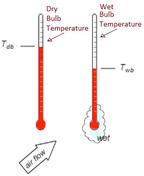Understanding Relative Humidity Tables and Charts
This page provides information on understanding and using a Relative Humidity Table or Chart. It explains the steps to determine the relative humidity value using a table or chart based on dry bulb and wet bulb temperatures.
Understanding Relative Humidity (RH)
- What it Measures: Relative humidity measures the amount of water vapor present in the air relative to the maximum amount the air can hold at its current temperature.
- How it’s Expressed: It’s expressed as a percentage (%).
- In Simpler Terms: Think of it as the actual amount of water vapor in the air compared to the total amount it could hold at that specific temperature.
For a deeper understanding of the different types of humidity, you can explore the difference between relative humidity, absolute humidity, and specific humidity.
Relative Humidity Table or Chart
Here’s an example of what a Relative Humidity Table or Chart looks like:

How to Read a Relative Humidity Table/Chart
Here’s a step-by-step guide to reading the table or chart:
Step 1: Record Temperatures
- Note down the dry bulb temperature (Td).
- Note down the wet bulb temperature (Tw).
Step 2: Calculate the Temperature Difference
- Subtract the wet bulb temperature (Tw) from the dry bulb temperature (Td).
- This is expressed as: (Td - Tw).
Step 3: Find the Values on the Chart/Table
- The chart or table will display dry bulb temperatures (Td) along the rows.
- The difference between the dry and wet bulb temperatures (Td - Tw) will be along the columns.
Step 4: Identify the Intersection
- Locate the cell where the row for your dry bulb temperature (Td) intersects with the column for your calculated temperature difference (Td - Tw).
Step 5: Determine the Relative Humidity
- The value found in the intersecting cell represents the relative humidity. This value will be expressed as a percentage.
Conclusion
Relative humidity tables and charts serve as essential tools in climate control, agriculture, manufacturing, and meteorology. They help in following:
- Predicting moisture content in air for preventing condensation and mold growth.
- Maintaining optimal humidity levels in storage facilities to preserve food, pharmaceuticals, and electronics.
- Improving HVAC efficiency by adjusting humidity levels for energy savings.
By interpreting humidity charts correctly, industries and individuals can make informed decisions to maintain ideal environmental conditions and prevent potential damage due to excess or insufficient moisture.
 T&M
T&M 




